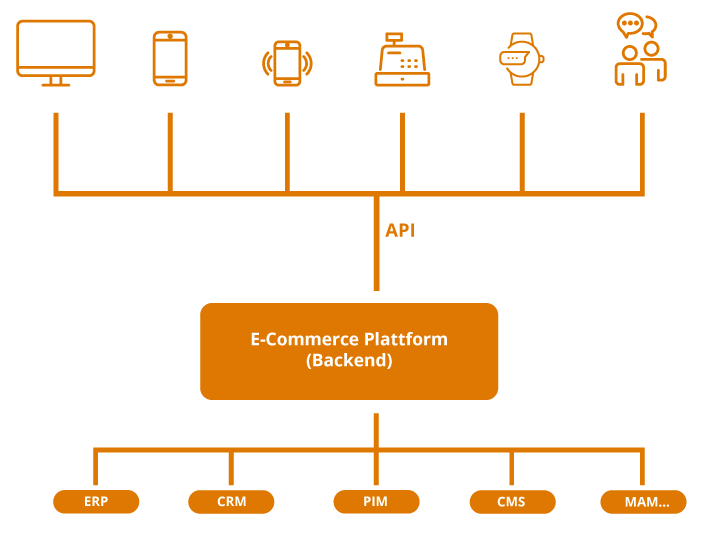Approach the technical substructure step by step
As explained in our blog article "Why your company (finally) really needs to get started with digital sales”, e-commerce continues to be a very attractive and promising way to sell products. Once your company has decided to get off the ground with its own online store, some technical planning is necessary.
Because: An online store is not just an online store! If you start too quickly, there is a high risk that you will forget important aspects or not think them through enough. That's why we explain here what you need to pay attention to.
Basics and strategy
Many companies that enter the digital sales arena without any forethought begin their technical planning with the selection of an onlineshop system. A mistake! Because if you don't know exactly what you need now and in the future, you can't make an adequate selection.
The basis of all your e-commerce activities should always be your strategy. In the last blog post, we explained what to look out for. Among other things, you have to define a precise target group and the type of distribution. When working it out, think not only about the here and now, but also about the medium and long-term future.
Perhaps you would like to intensively link your branch stores with your online store, i.e. operate crosschannel commerce? Perhaps your objective is "online only"? Or are you thinking about connecting many new channels as part of an omnichannel strategy and following the latest trends at short notice?
Record exactly where your journey could go. Your strategic requirements have a massive influence on the technical implementation of your digital sales. Because some technologies may not be flexible enough to allow you to easily master your plan. In the worst case, you could end up in a technical dead end.
Actual state analysis and target definition
Evaluate the situation: Which technologies are already available in your company? Do you have a CRM, ERP or PIM system? Are you already using a CMS or even an onlineshop system? In short: What does your IT system landscape look like?
This evaluation of the current situation will show you whether structures already exist in your company that you could possibly use for your e-commerce strategy. But: Even if some systems are already there, this does not necessarily mean that you will use them for your digital sales!
First, create a target definition, i.e., what do the systems have to do in the medium and long term so that you can fulfill your e-commerce strategy? For example, ask yourself whether your ERP is still up to date, or whether your CMS can play out the content on all desired channels.
Hosting and scalability
Think hard about the hosting of your online store. If you want to keep everything in your own hands, you need to operate your own servers, maintain them and improve them further. If on-premise is too time-consuming or expensive for you, or if you don't have the necessary skills, cloud hosting is a good option - or a hybrid solution consisting of your own and third-party server capacities.
Here, too, it is important to look to the future. If you are aiming for rapid growth in your digital sales, your hosting capacities must be high-performance and scalable. And you should factor in peak loads for promotions and other campaigns (Christmas, Black Friday & Co.).
And: Don't just think about your - potential - onlineshop system when it comes to hosting scaling. You should also check the peripheral systems you are considering. Can your CRM really manage tens of thousands of customer records? Is your ERP fast enough to handle a rush of customers? Does your PIM deliver product information to users in remote countries fast enough?
Shopsystem and DXCP
From WooCommerce to Shopware and Shopify to Plentymarkets, SAP Commerce Cloud and Adobe Experience Cloud, there's an onlineshop system to suit almost any size of business and strategy. This means that selecting the right solution is a science in itself. Accordingly, you should deal with the topic intensively and not license the next best product.
Plan for the medium and long term! What seems appropriate today may be outdated tomorrow and a drag on your e-commerce activities the day after. That's why you should have a clear mission and vision for your business. If you are pursuing an "online only" strategy, you need a completely different system than if you are aiming for an omnichannel approach.
Under certain circumstances, your onlineshop system is only intended to be the substructure for something much bigger: The "vehicle" for a Digital Experience Commerce Platform (DXCP), where you can flexibly connect new marketing and sales channels.
Frontend and Headless
Speaking of flexibility: Before choosing the onlineshop system and other technologies, you should define whether and to what extent you want to separate the frontend and backend. A headless approach, such as Libro, is more time-consuming to maintain, but it does have some advantages. For example, it makes it easier to play out your products on different platforms.


If you know how your frontend should be technically implemented, your designers can start designing it. One step that goes hand in hand with this is choosing the right theme or template. Not only does it have to look good, but it also has to boast a snappy loading speed. In the Magento area, the Hyvä theme is very popular. It has a significantly reduced JavaScript code, which means that online stores load much faster than usual - which has a positive effect on the customer experience and SEO measures.
Implementation and support
Once the technical framework is in place, the next step is to plan your implementation. Decide whether you want to implement as much as possible in-house or externally, as with hosting. Both approaches have their individual advantages and disadvantages: Service providers may be more expensive than your own e-commerce team, but you have flexible access to expertise and resources.
When weighing up the pros and cons, you should also think medium and long-term here. The development and support of an online store is not a short-term project, but a permanent investment. If you don't constantly keep your finger on the pulse, you may quickly be left behind technically - and thus lose touch with your customers' wishes.
Questions that must always be on the agenda when planning the technical implementation are: How do you want to develop your online store? Do you use a classic project management method such as the waterfall model? Or do you prefer to follow an agile approach like Scrum? Find out which approach best suits your company and your service providers.
Conclusion: An online store needs clean technology planning
You see: Even from a technical perspective, getting started in digital sales and thus in e-commerce is anything but easy. You have numerous aspects to clarify, sort through and sort out - and you have to do this with various stakeholders. This makes the whole thing not only complicated, but also complex.
But with a basic strategy and thoughtful planning, you can master the challenges very well. It's best to find an experienced e-commerce freelancer or an onlineshop agency for support. This way, you avoid unnecessary wrong decisions and speed up the implementation processes.
And remember another point we haven't addressed yet: Your budget. If you don't have enough funds to implement the best strategic and technical solution, you will have to make some compromises. Nevertheless, never lose sight of the possible, future development when planning your technical solution. Don't rely on monoliths that make growth difficult, but on flexible systems.








